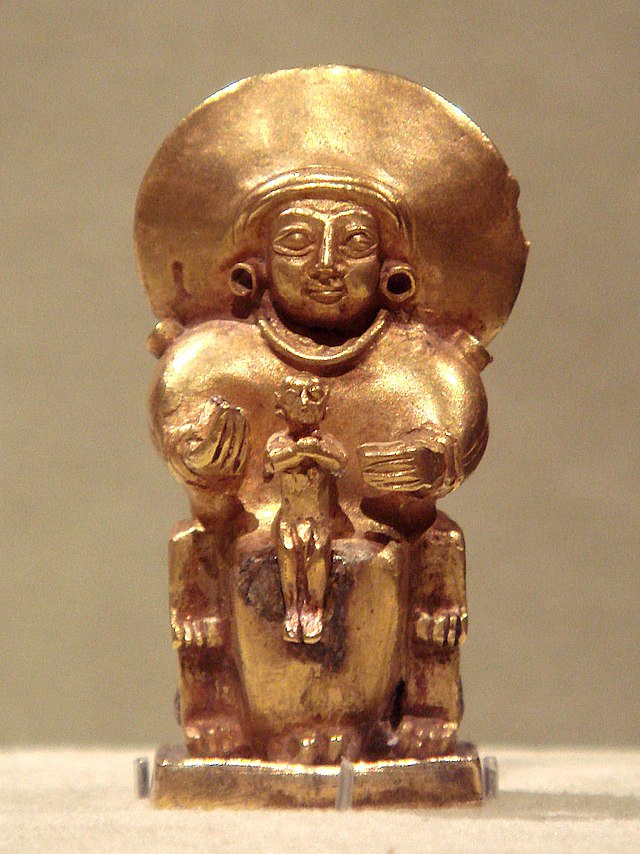Loading AI tools
*Seh₂ul and *Meh₁not are the reconstructed Proto-Indo-European Sun deity and Moon deity respectively. *Seh₂ul is reconstructed based on the solar deities of the attested Indo-European mythologies, although its gender (male or female) is disputed, since there are deities of both genders.[1] Likewise, *Meh₁not- is reconstructed based on the lunar deities of the daughter languages, but they differ in regards to their gender.
This article should specify the language of its non-English content, using {{lang}}, {{transliteration}} for transliterated languages, and {{IPA}} for phonetic transcriptions, with an appropriate ISO 639 code. Wikipedia's multilingual support templates may also be used. (January 2024) |
The daily course of *Seh₂ul across the sky on a horse-driven chariot is a common motif among Indo-European myths.[note 1] While it is probably inherited, the motif certainly appeared after the introduction of the wheel in the Pontic–Caspian steppe about 3500 BC, and is therefore a late addition to Proto-Indo-European culture.[3]

*Seh₂ul is reconstructed based on the Greek god Helios, the Greek mythological figure Helen of Troy,[4][5] the Roman god Sol, the Celtic goddess Sulis / Sul/Suil, the North Germanic goddess Sól, the Continental Germanic goddess *Sowilō, the Hittite goddess "UTU-liya",[6] the Zoroastrian Hvare-khshaeta[6] and the Vedic god Surya.[7]
In Albanian the Sun – worshiped as the god of light, sky and weather, giver of life, health and energy, and all-seeing eye[8] – is referred to as Dielli, a name that is considered to have been a word taboo originally meaning "yellow, golden, bright/shiny one" used to refer to the Sun due to its perceived sacred nature.[9]
In the mythologies of the daughter languages (namely, Baltic, Greek and Old Indic), the sun deity crosses the sky in a horse-driven chariot or wagon. However, Mallory and Adams caution that the motif is not exclusively Indo-European, and mention evidence of its presence in Mesopotamia.[10]
Sun-maiden
A character related to the Sun deity is the 'Sun-maiden'.[11] Examples are 'Saules meita', the daughter of Saulé in Baltic tradition, and Sūryā, daughter to Indic Sun god Sūrya.[12] Scholars also posit Helen of Troy, from Greek mythology, was another example of the 'Sun-maiden'.[7][13]
In Albanian tradition there is E Bija e Hënës dhe e Diellit, "the Daughter of the Moon and the Sun", who is a light divine heroine, referred to as pika e qiellit ("drop of the sky" or "lightning"), which falls everywhere from heaven on the mountains and the valleys and strikes pride and evil. She defeats the kulshedra, the archetype of darkness and evil in Albanian mythology.[14][15][16] In some Albanian traditions the Sun (Dielli) and the Moon (Hëna) are regarded as husband and wife, and in others as brother and sister. In the case of E Bija e Hënës dhe e Diellit the Sun is her father and the Moon is her mother.[17][18]

*Meh₁not- is reconstructed based on the Norse god Máni, the Slavic god Myesyats,[note 2][6] and the Lithuanian god *Meno, or Mėnuo (Mėnulis).[21] Remnants of the lunar deity may exist in Latvian moon god Mēness,[22] Anatolian (Phrygian) deity Men;[23][22] Mene, another name for Selene, and in Zoroastrian lunar deity Mah (Måŋha).[24][25][26]

Although the sun was personified as an independent deity,[27] the Proto-Indo-Europeans also visualized the sun as the "lamp of Dyēws" or the "eye of Dyēws", as seen in various reflexes: "the god's lamp" in Medes by Euripides, "heaven's candle" in Beowulf, or "the land of Hatti's torch", as the Sun-goddess of Arinna is called in a Hittite prayer;[28] and Helios as the eye of Zeus,[29][30] Hvare-khshaeta as the eye of Ahura Mazda, and the sun as "God's eye" in Romanian folklore.[31] The names of Celtic sun goddesses like Sulis and Grian may also allude to this association: the words for "eye" and "sun" are switched in these languages, hence the name of the goddesses.[32]
Albanian solemn oaths are taken "by the eye of the Sun" (për sy të Diellit), which is related to the Sky-God worship (Zojz).[33]
Egyptian mythology is unrelated to Indo-European mythology so there is unlikely any historical link, but the metaphor of Eye of Ra was used in it too.
Wikiwand in your browser!
Seamless Wikipedia browsing. On steroids.
Every time you click a link to Wikipedia, Wiktionary or Wikiquote in your browser's search results, it will show the modern Wikiwand interface.
Wikiwand extension is a five stars, simple, with minimum permission required to keep your browsing private, safe and transparent.